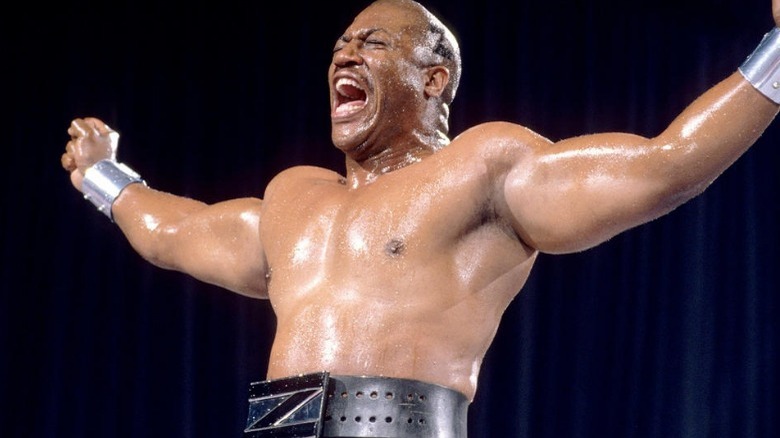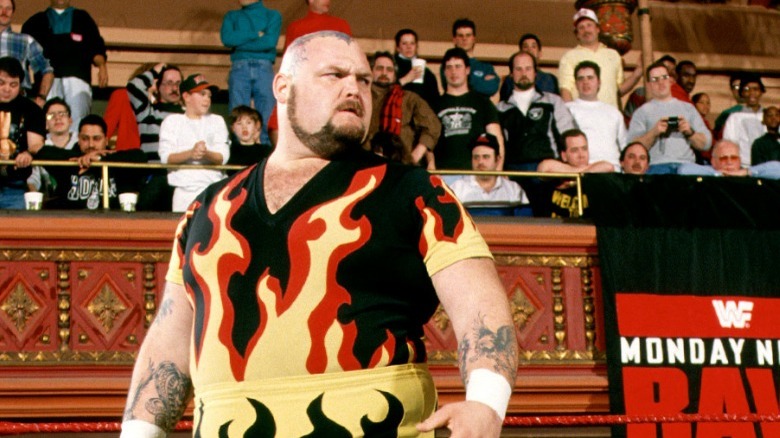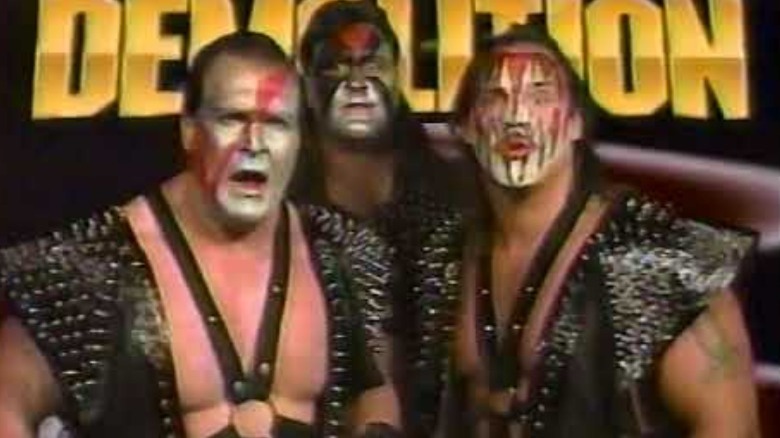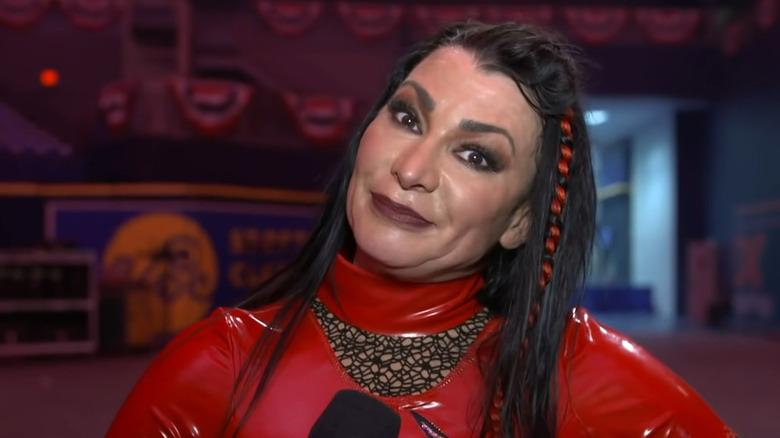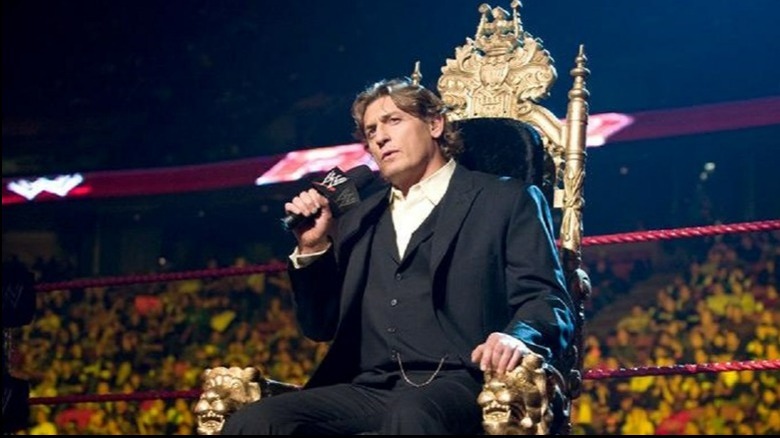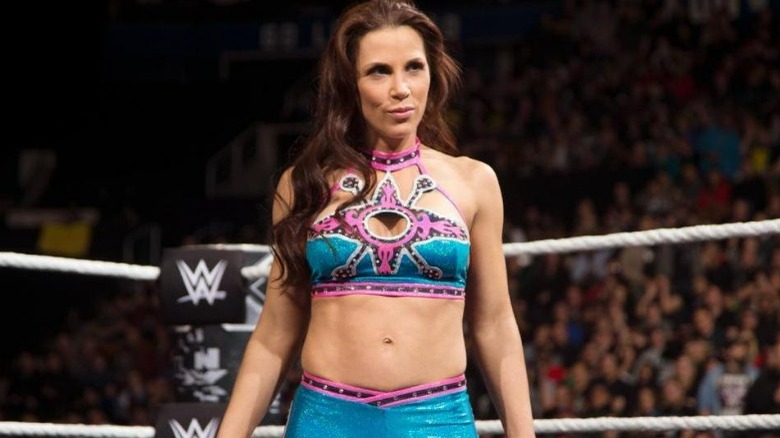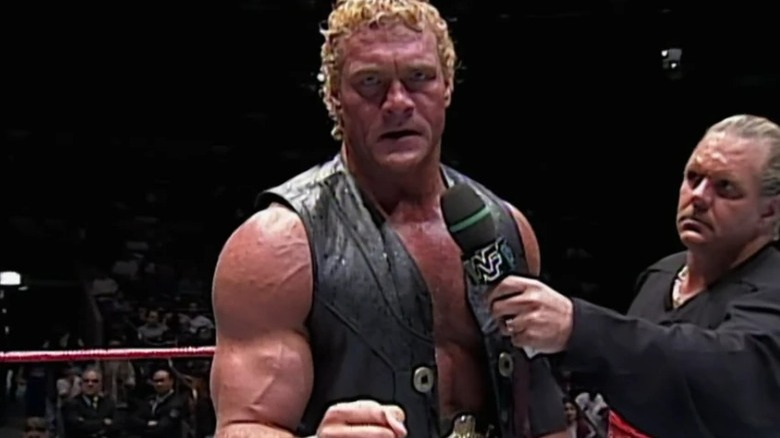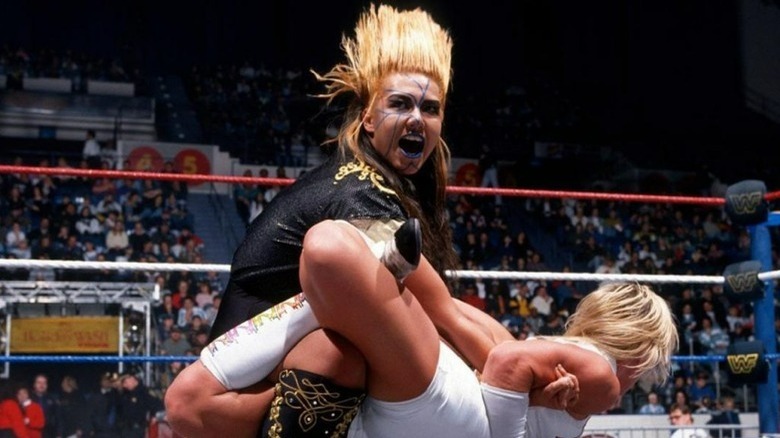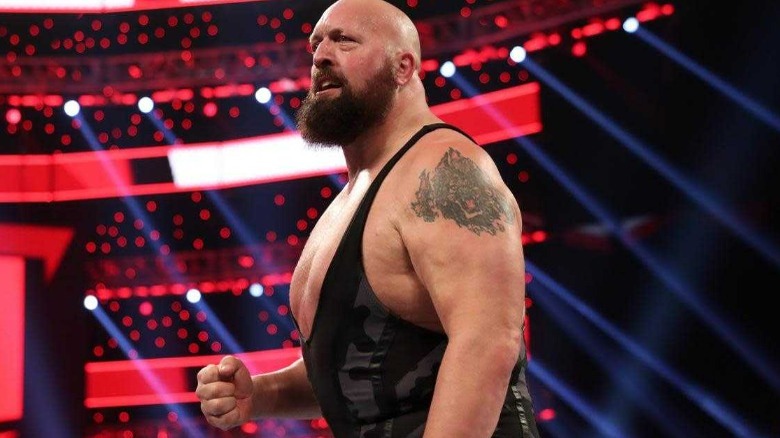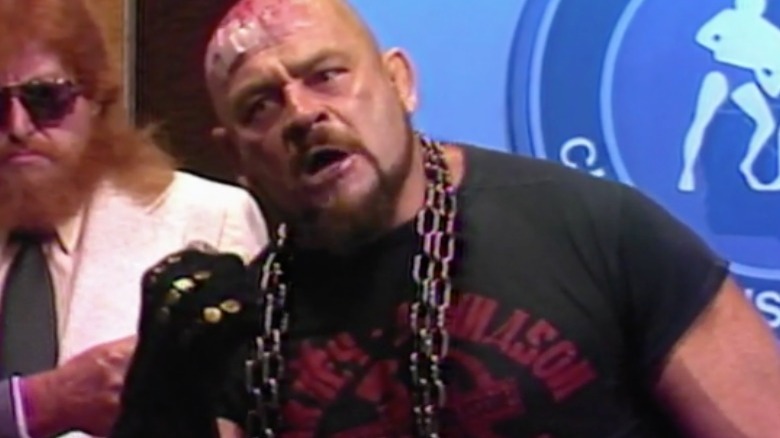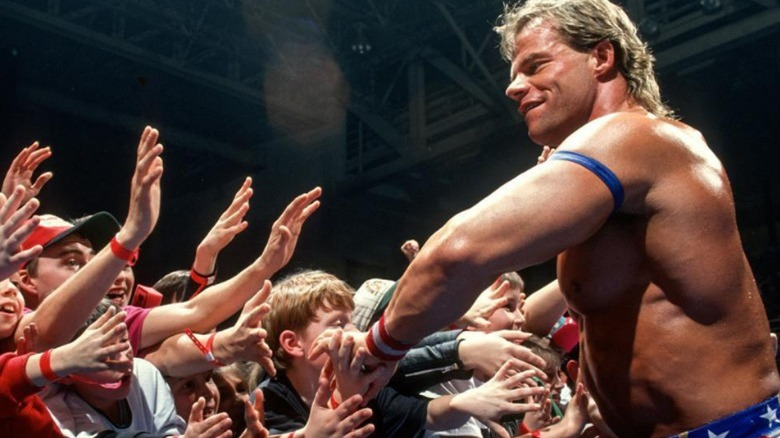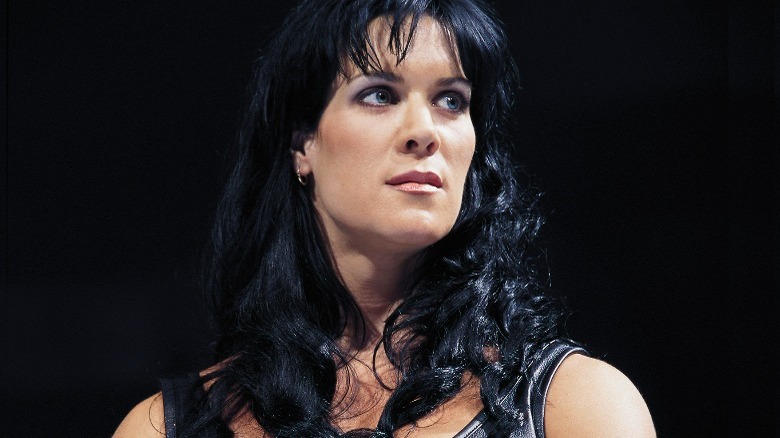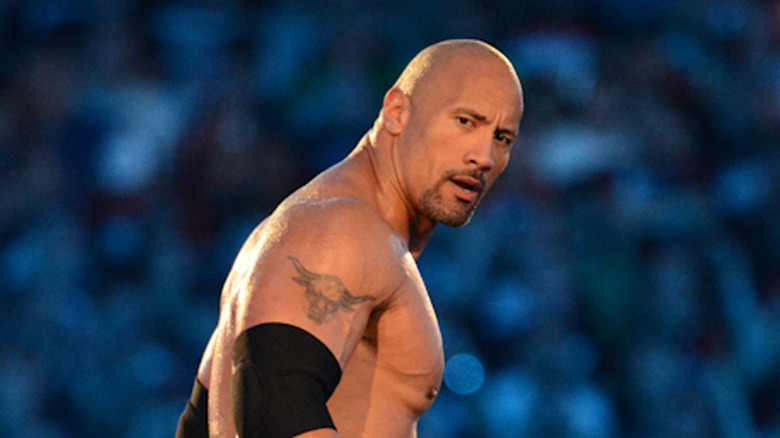The Best Wrestlers That Haven't Made The WWE Hall Of Fame
Throughout its existence, the WWE has hosted an innumerable number of wrestlers, giving them a platform to do what they do best. While it's the goal of just about everyone who enters the company to leave their mark on it and the fans, some are far more successful at it than others. For those who prove particularly gifted in the ring, accumulate impressive collections of championships, or are generally remarkable on-screen talents, they're awarded with an induction into the WWE Hall of Fame whenever they decide to hang up their boots for good.
Since its establishment in 1993 with the induction of André the Giant, the Hall of Fame has come to include a who's who of WWE legends. Hulk Hogan, "Stone Cold" Steve Austin, the Undertaker, Shawn Michaels, and more have taken their place among the absolute best to ever step into a WWE ring. Many have questioned the legitimacy of WWE's Hall of Fame, and the celebrity wing has drawn some heavy criticism, but at the end of the day, it's an honor to be recognized as an all-time great. That said, the Hall of Fame is far from complete.
Even with the accolades making them eligible to do so, these notable names still have yet to join the WWE Hall of Fame for one reason or another.
Zeus
Back in 1989, a film known as "No Holds Barred" from director Thomas J. Wright was released. It follows Hulk Hogan as pro wrestler Rip Thomas as he embarks on a feud with an up-and-coming titan of the ring named Zeus (Tommy "Tiny" Lister Jr.). After the film hit theaters, Zeus made his way to the WWF to continue his cinematic feud with Hogan, aligning with Hogan's former Mega Powers teammate "Macho Man" Randy Savage. To combat these two villains, the Hulkster enlisted the aid of Brutus "The Barber" Beefcake, who helped him to victory in a tag team match against Zeus and Savage at SummerSlam 1989.
Despite the loss, Zeus didn't disappear from the WWF scene entirely after SummerSlam. He returned at Survivor Series in November as part of the Million Dollar Team ("Million Dollar Man" Ted DiBiase, the Barbarian, and the Warlord) in hopes of defeating Hogan and his Hulkamaniacs (Ax, Smash, and Jake "The Snake" Roberts). Once again, Zeus failed to overcome Hogan, so he challenged him to one last WWF match at the WWF No Holds Barred – The Match/The Movie event. Again, he and Savage lost to Beefcake and Hogan, bringing his WWF tenure to an end on a down note.
Zeus went on to have brief, uneventful runs in the World Wrestling Council and World Championship Wrestling. However, for his WWF efforts alone, he deserves a spot in the WWE Hall of Fame. Sure, he wasn't exactly the most gifted wrestler between the ropes, since Tiny Lister was predominantly an actor. That said, getting to headline pay-per-views alongside Hulk Hogan in one of the most iconic feuds of the 1980s has to count for something.
Bam Bam Bigelow
Scott "Bam Bam" Bigelow got his start in professional wrestling in the mid-1980s under the Continental Wrestling Association banner, but it didn't take him long after that to gain a national spotlight. He signed with the WWF by 1987 and began working as a babyface against the likes of One Man Gang and "Million Dollar Man" Ted DiBiase. However, he'd leave the promotion by 1988 and hone his craft in WCW, the Universal Wrestling Federation, and other companies. Unsurprisingly, given his unique look and entertaining style between the ropes, his WWF return came to fruition by the end of 1992.
This time around, Bigelow fared much better in the WWF. As a heel, he joined DiBiase's Million Dollar Corporation, nearly won the 1993 King of the Ring Tournament, and even competed for the WWF Championship. Perhaps most notably, he battled NFL sensation Lawrence Taylor in the main event of WrestleMania XI, though he couldn't score a win over "L.T." After leaving the WWF again in 1995, Bigelow would stop by Extreme Championship Wrestling and win the ECW World Heavyweight and World Television Championships before heading back to WCW, where he remained until it closed its doors in 2001.
Even though his career wasn't too long, Bam Bam Bigelow accomplished a lot in his day. Had it not been for his untimely death in 2007, surely he would've accomplished much more. Regardless, "The Beast from the East" is a wrestling legend no matter how you slice it, having found some measure of success no matter where he went. Bigelow is more than deserving of a spot in the WWE Hall of Fame.
Demolition (Ax, Smash, Crush)
As the face paint-wearing, spikes-clad tag team the Road Warriors (Hawk and Animal) rose to prominence as one of wrestling's biggest duos, the WWF wanted in on the action. Thus, Bill Eadie and Randy Colley — who was replaced by Barry Darsow in short order — formed the tag team Demolition. Dubbed Ax and Smash, respectively, Eadie and Darsow began tearing through the WWF tag team division in 1987 and went undefeated for their first few months as a unit. Their dominance culminated in a WrestleMania IV match against Strike Force (Rick Martel and Tito Santana) where they won their first WWF Tag Team Championship.
Demolition would hold onto the titles for an astounding 478 days — the longest reign in the company's history for decades until the New Day (Xavier Woods, Kofi Kingston, and Big E) eclipsed it at 483 days — and become immensely popular with WWF fans. They'd win the titles twice more throughout their time with the promotion and famously clash with the Road Warriors (renamed the Legion of Doom) once they joined the WWF in 1990. In the wake of WrestleMania VI, Crush would join Demolition, though by this point, the team had lost a considerable amount of steam. Demolition would ultimately disband by the end of 1991.
As one of WWE's most recognizable tag teams, Demolition is entirely worthy of a WWE Hall of Fame induction. However, according to Ax, their involvement in a class-action lawsuit against WWE due to perceived negligence toward past head injuries has likely prevented them from receiving the nod. One can only hope that if this is indeed the case, Demolition and WWE can make amends sooner rather than later.
Victoria
With bodybuilding and general fitness experience under her belt, Lisa Marie Varon took her first steps into the world of professional wrestling in 2000. After a one-off appearance alongside the Godfather at WrestleMania 2000, she made her proper televised WWE debut in 2002 and immediately shot to the top of the women's division. Renamed Victoria, she'd launch what would become a lengthy feud with fellow rising star Trish Stratus, winning her first WWE Women's Championship in the process. As champion, she'd tear through the likes of Molly Holly, Jacqueline, Stacy Keibler, and more.
Upon losing the title at WrestleMania XIX, Victoria didn't fade into obscurity in the aftermath. She continued to feature prominently on WWE programming, even regaining the WWE Women's Championship by the start of 2004. She defeated Holly in a title vs. hair match at WrestleMania XX, aligned herself with Torrie Wilson and Candice Michelle to form the Vince's Devils faction in 2005, and jumped from "Raw" to "SmackDown" in 2007, taking on a whole new set of opponents. As her WWE run came to a close in 2009, she worked with upstarts such as Natalya and Nikki and Brie Bella.
A solid worker between the ropes and an entertaining character, Victoria was a standout in WWE's women's division throughout the Ruthless Aggression Era. Not to mention, she proved a fine addition to Impact Wrestling's Knockouts division from 2009 to 2013 — with the championship gold to prove it. One can only hope that someday soon she gets the recognition she deserves in the form of a WWE Hall of Fame induction.
William Regal
Under the tutelage of Marty Jones, a kid by the name of Darren Matthews got his start in the squared circle in the mid-1980s. With a natural talent for the sport, it didn't take him long to get on the radar of some pretty major wrestling promotions. By 1993, he'd sign a contract with WCW, bringing his ring name, Steve Regal (later changed to Lord Steven Regal), and his ring proficiency with him. He'd find moderate success there during his two stints — the first from '93 to '98, the second from '99 to 2000 — as both a solo and tag team competitor, but it didn't quite measure up to his WWF-WWE run.
Following a brief stint in the WWF from 1998 to 1999 as the "Real Man's Man," he returned in 2000 as William Regal. In the waning days of the WWF Attitude Era and into the Ruthless Aggression Era, he'd play a scheming, snobbish heel who found himself at odds with names like Chris Jericho, Triple H, and CM Punk, to name a few. He held several championships, win the King of the Ring tournament in 2008, and even became the general manager of "Raw" for a time. As his main roster career drew to a close in the early-2010s, he became a regular on "WWE NXT," working with young talent behind-the-scenes and acting as an on-air authority figure.
It goes without saying that William Regal has done it all in professional wrestling, and despite retiring in 2013 in an incredible match against Antonio Cesaro, he's not finished yet. As of this writing, he's currently the mastermind behind AEW's Blackpool Combat Club faction, featuring Bryan Danielson, Wheeler Yuta, Jon Moxley, and the former Cesaro, Claudio Castagnoli. Nevertheless, he's a surefire WWE Hall of Fame inductee when the time is right.
Mickie James
With only a few years experience to her, having debuted in 1999, Mickie James (then known by the ring name Alexis Laree) stepped between the ropes virtually anywhere that would have her. Women's Extreme Wrestling, Ultimate Championship Wrestling, Ring of Honor, and even NWA: Total Nonstop Action invited her to work against their top talent, and Laree rarely disappointed. Thus, by 2004, she began working in WWE's developmental territory, Ohio Valley Wrestling, where she continued to impress. The following year, she'd appear on "Raw" for the first time as Mickie James, kicking off her biggest wrestling feud yet.
In the lead-up to WrestleMania 22, James would go from Trish Stratus' biggest fan to her biggest threat, taking the WWE Women's Championship from her at the aforementioned event. In the following years, she'd remain a fixture of the women's division who never backed down from a challenge. Along the way, she'd pick up four more WWE Women's Championships and one WWE Divas Championship, overcoming legends like Lita, Michelle McCool, Beth Phoenix, and others to do so. James left the company in 2010, but she didn't lose a step upon signing with TNA, as evidenced by her numerous incredible matches and title reigns.
After a stint in TNA from 2010 to 2013, Mickie James enjoyed another run in WWE from 2016 to 2021. She also participated in the 2022 women's Royal Rumble match, bringing the Impact Knockouts World Championship with her. James continues to turn in solid promo and in-ring work for Impact Wrestling, though she's implied the end of her career is in sight. When it does eventually reach its inevitable conclusion, one has to imagine a WWE Hall of Fame induction is in order.
Sid Vicious
Wrestling fans met Sid Eudy for the first time in the late 1980s when he made a splash in Continental Championship Wrestling as Lord Humungous. Of course, it didn't take long for this moniker to go the way of the dinosaur in favor of the one most would come to recognize him under: Sid Vicious. As 1990 crept closer, Sid signed with WCW and teamed with Danny Spivey to form the Skyscrapers tag team. Moving on from that tandem, Sid became a member of the illustrious Four Horsemen stable, rubbing shoulders with the likes of "Nature Boy" Ric Flair, Barry Windham, and Arn Anderson prior to his 1991 WCW departure.
Sid then jumped to the WWF where he famously faced Hulk Hogan at WrestleMania VIII before bidding the company farewell in 1992. He went back to WCW and stopped by the United States Wrestling Association from there, but ultimately made his WWF return in 1995. During this run, he'd compete against such legends as the Undertaker and Shawn Michaels and hold the WWF World Heavyweight Championship twice. Nevertheless, this success wasn't enough to keep him from heading back to WCW once again in 1999. He added two WCW World Heavyweight Championship and one WCW United States Championship reigns to his résumé by WCW's closure.
With WCW gone, Sid made sporadic appearances across the wrestling world leading up to his official retirement in 2017. A true journeyman, "The Millennium Man" may not have been the most skilled athlete, gifted talker, or engaging on-screen personality, but he's enjoyed a legendary career nonetheless. Sid, Sid Justice, Sycho Sid, whatever you choose to call him, it's evident that he should've landed a spot in the WWE Hall of Fame a long time ago.
Bull Nakano
All Japan Women's Pro-Wrestling became a proving ground for a young athlete named Keiko Nakano in 1983, as she began her studies of professional wrestling. Suffice to say, she showed loads of potential in the ring, resulting in her taking on the name Bull Nakano and steamrolling the competition. Naturally, championship gold followed, and by the early '90s, she looked to new wrestling horizons. Nakano briefly appeared for the Consejo Mundial de Lucha Libre (CMLL) promotion in Mexico, and when she wrapped up there, she headed to the United States with plans to conquer the WWF women's division.
Bull Nakano made quite the impact in the WWF in 1994 as she made a beeline for Alundra Blayze's WWF Women's Championship. On television and at non-televised events the two would square off leading up to SummerSlam that year, where Blayze would narrowly hold onto her title. However, she was only delaying the inevitable, seeing as Nakano eventually told the gold from her at AJW Doumu Super Woman Great War — Big Egg Wrestling Universe in November of 1994. Blayze regained the championship in April of 1995, and in doing so, she concluded Nakano's run in the company.
With the WWF behind her, Bull Nakano competed in a handful more matches in various promotions before retiring from active competition in 1996. A dominant competitor with a unique look, Nakano worked hard to legitimize women's wrestling in an era where interest had waned significantly. For her contributions to professional wrestling and all of her accomplishments, she undoubtedly belongs in the WWE Hall of Fame.
Big Show
When talking about giants of professional wrestling, it's impossible not to name drop one of the biggest and most recognizable: Paul Wight. Standing at seven feet tall, it should come as no surprise that WCW scooped him up in the mid-1990s, dubbed him "The Giant," and immediately put him in a feud with recent acquisition Hulk Hogan. He may've been a tad on the green side, but his presence went a long way covering for his inexperience. As a result, he took Hogan to task, joined the New World Order faction, and won numerous championships in the company before he jumped ship to the WWF in 1999.
Introduced as Paul Wight before becoming the Big Show, he became a prolific presence on WWF television after aligning himself with Vince McMahon at St. Valentine's Day Massacre: In Your House. As the Attitude Era gave way to the Ruthless Aggression Era, Show fluctuated from a mid-card wrestler to a main-eventer and worked as a singles and tag team star. Regardless of his position on the card, though, he never ceased to entertain, churning out memorable feuds with Brock Lesnar, John Cena, and more. Even late into his in-ring career, he kept busy against Alberto Del Rio, Braun Strowman, Mark Henry, and a host of others.
The Big Show left the WWE scene in 2021 in favor of AEW, where he's wrestled a handful of one-off matches while predominantly working backstage. It's safe to assume that his days in the ring are numbered, and that's just fine. He's won several championships in different promotions, competed against the best to ever lace up a pair of boots, and entertained fans worldwide. That sounds like a WWE Hall of Fame-caliber career for sure.
Ivan Koloff
Montreal, Quebec, Canada native Oreal Perras burst onto the wrestling scene in the 1960s as a character named Red McNulty. However, this name isn't the one he'd use to become a legend of the squared circle. Perras would do so as "The Russian Bear" Ivan Koloff, a villain who had plans to dismantle all who dared step up to him and earn championship gold along the way. Proving quite the menace by plowing through Arnold Skaaland, Gorilla Monsoon, Pete Sanchez, and others, Koloff inevitably wound up on the radar of then-WWWF World Heavyweight Champion Bruno Sammartino.
Though he defeated Koloff on several occasions, on January 18, 1971, "The Russian Bear" shocked the world. He did the impossible by defeating Sammartino for the championship, pinning him in the center of the ring in New York City's Madison Square Garden and snapping his historic 2,803-day title reign. Koloff didn't end up holding the championship long, but the fact that he beat Sammartino for it in the first place made him quite the buzz-worthy name. In the two decades that followed, he'd continue to find success around the world — most notably teaming with Nikita Koloff against National Wrestling Alliance mainstays like Dusty Rhodes and the Road Warriors.
By the mid-1990s, Ivan Koloff's active career came to an end. Prior to his death in 2017, he'd only work a small few one-off matches with the final being against "Bullet" Bob Armstrong. As one of wrestling's most dastardly heels, the man who defeated Bruno Sammartino for the WWWF World Heavyweight Championship, and an NWA icon, it's a travesty that Koloff isn't in the WWE Hall of Fame as of yet.
Lex Luger
With an attempted career in professional football behind him, Lawrence Pfohl sought out a much different path in the late 1980s: professional wrestling. Known as Lex Luger between the ropes, he got the ball rolling on this new career avenue via Championship Wrestling Florida and later WCW — the promotion where he'd gain some serious momentum. "The Total Package" joined the Four Horsemen, appeared on pay-per-view after pay-per-view, and won championships galore. Thus, with his stock in the business rising quickly, Luger signed with the WWF in 1993 to become "The Narcissist."
This pompous, self-centered gimmick didn't last long, however, seeing as the WWF had plans to make Luger the face of the company. With Hogan gone, it needed a new all-American hero, so he received the push of a lifetime. Sadly for him, Luger didn't become WWF World Heavyweight Champion nor did he become the top guy. He exited the promotion in 1995. When he returned to WCW, he famously feuded with and later joined the New World Order and added to his title collection a few times before WCW closed up shop. His final stint in a major promotion was in 2003 for NWA: Total Nonstop Action.
Four years later, Lex Luger would suffer a nerve impingement in his neck that left him paralyzed from the neck down, ending his in-ring career. Thankfully, in the years since, he's regained the use of his limbs, and should he enter the WWE Hall of Fame down the road, he's more than ready to do so on his own two feet. Whether or not that day will come remains to be seen — his link to the death of beloved wrestling manager Miss Elizabeth continues to call the likelihood of this happening into question — though he certainly deserves the honor based on his in-ring accomplishments alone.
Chyna
Joan Laurer — working under the alias Joanie Lee — found her footing in wrestling in 1996, and before long, she was on top of the world. In February of 1997, she arrived in the WWF as Chyna: a close ally of Triple H who'd go on to join the D-Generation X faction alongside him, Shawn Michaels, and Rick Rude. She spent much of her early days in the company as DX's enforcer and wouldn't actually have her first match until late 1998 when she teamed with X-Pac in a losing effort against Mark Henry. Once she got in the ring more often, though, no one had a chance at stopping her.
As an in-ring performer, Chyna accomplished numerous things in the WWF, in addition to clobbering folks such as Chris Jericho, Trish Stratus, and Jeff Jarrett. First and foremost, she's the first and so far only woman to hold the WWF Intercontinental Championship, having won the title three times. "The Ninth Wonder of the World" is also the first woman to enter the Royal Rumble when she participated in the 1999 match. Capping off her achievements, she won the WWF Women's Championship one time when she defeated Right to Censor member Ivory at WrestleMania X-7 in April of 2001.
Chyna left the WWF in 2001, moving on to New Japan Pro-Wrestling and TNA in the years that followed to finish out her wrestling career. At the age of 46, she was found dead on April 20, 2016, and went into the WWE Hall of Fame as a member of D-Generation X in 2019. While that's an honor in and of itself, as a true trailblazer of women's wrestling, it's fair to say she deserves a solo induction as soon as possible.
The Rock
The son of "Soulman" Rocky Johnson and grandson of Peter Maivia, Dwayne Johnson got to work becoming a professional wrestler in 1996. By the year's end, he'd make his WWF debut as Rocky Maivia at the Survivor Series event. Little did fans realize then, but they were in the presence of one of wrestling's biggest future stars. After turning heel and joining the Nation of Domination faction, Maivia would find his groove both in the ring and on the microphone. This would lead him to strike out on his own by 1998 and blossom into a true main-event-level star known simply as the Rock.
Throughout the remainder of the Attitude Era, "The Brahma Bull" locked horns with "Stone Cold" Steve Austin, headlined one WrestleMania after another, and filled his trophy case with championship gold. He continued to prosper into the Ruthless Aggression Era — that is, until he left the WWE in 2004 in favor of the bright lights of Hollywood. Though he didn't find immediate silver screen success, he's since become one of the biggest movie stars of his era. That said, that hasn't prevented him from returning to the ring to take on the likes of John Cena and CM Punk and even regain the WWE Championship.
The Rock hasn't necessarily confirmed that he's 100% done with wrestling. In fact, with each passing WrestleMania, it's expected that the return of "The Great One" is right around the corner. Then again, it stands to reason his days as an active wrestler are long over, making him a prime candidate for the WWE Hall of Fame. After all, it's not like he doesn't already have the qualifications to receive the honor. One has to imagine it's only a matter of time before he takes his proper place among the best of the best.

